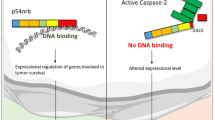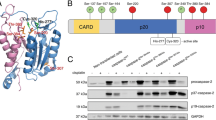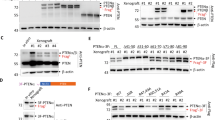Abstract
The adenomatous polyposis coli (APC) tumor suppressor is inactivated by mutation in most colorectal tumors. APC is a component of the Wnt signaling pathway and is best known for its ability to downregulate β-catenin and consequent effects on transcriptional regulation. Previous work demonstrated that APC accelerates apoptosis-associated caspase activity independently of transcription, and suggested novel tumor suppressor functions of APC. In this work, we have mapped the APC apoptosis-accelerating region to amino acids (aa) 1–760 by testing a series of non-overlapping APC segments. Interestingly, this segment corresponds to a stable group II caspase cleavage product of APC released during apoptosis that includes the amino-terminal aa1–777. Mutation of the APC aspartic acid residue at position 777 to an alanine completely abolished in vitro cleavage of APC by a recombinant group II caspase and rendered the full-length protein unable to accelerate apoptosis in vitro. A truncated APC protein associated with familial and sporadic colorectal cancer, also unable to accelerate apoptosis in vitro and in vivo, is resistant to group II caspase cleavage. These results demonstrate that cleavage of APC and the subsequent release of an amino-terminal segment are necessary for the transcription-independent mechanism of APC-mediated apoptosis.
This is a preview of subscription content, access via your institution
Access options
Subscribe to this journal
Receive 50 print issues and online access
$259.00 per year
only $5.18 per issue
Buy this article
- Purchase on Springer Link
- Instant access to full article PDF
Prices may be subject to local taxes which are calculated during checkout




Similar content being viewed by others
References
Barton MC, Madani N, Emerson BM . (1993). The erythroid protein cGATA-1 functions with a stage-specific factor to activate transcription of chromatin-assembled beta-globin genes. Genes Dev 7: 1796–1809.
Browne SJ, MacFarlane M, Cohen GM, Paraskeva C . (1998). The adenomatous polyposis coli protein and retinoblastoma protein are cleaved early in apoptosis and are potential substrates for caspases. Cell Death Diff 5: 206–213.
Fasschon DM, Couture C, Mustelin T, Newmeyer DD . (1997). Temporal phases in apoptosis defined by the actions of Src homology 2 domains, ceramide, Bcl-2, interlukin-1b converting enzyme family protease, and a dense membrane fraction. J Cell Biol 137: 1117–1125.
Goss KH, Groden J . (2000). Biology of the adenomatous polyposis coli tumor suppressor. J Clin Oncol 18: 1967–1979.
Groden J, Gelbert L, Thliveris A, Nelson L, Robertson M, Joslyn G et al. (1993). Mutational analysis of patients with adenomatous polyposis: identical inactivating mutations in unrelated individuals. Am J Hum Genet 52: 263–272.
Kim K, Pang KM, Evans M, Hay ED . (2000). Overexpression of b-catenin induces apoptosis independent of its transactivation function with LEF-1 or the involvement of major G1 cell cycle regulators. Mol Biol Cell 11: 3509–3523.
Korinek V, Barker N, Morin PJ, van Wichen D, de Weger R, Kinzler KW et al. (1997). Constitutive transcriptional activation by a beta-catenin-Tcf complex in APC−/−colon carcinoma. Science 275: 1784–1787.
Lillard-Wetherell K, Machwe A, Langland GT, Combs KA, Behbehani GK, Schonberg SA et al. (2004). Association and regulation of the BLM helicase by the telomere proteins TRF1 and TRF2. Hum Mol Genet 13: 1919–1932.
Newmeyer DD, Farschon DM, Reed JC . (1994). Cell-free apoptosis in Xenopus egg extracts: inhibition by Bcl-2 and requirement for an organelle fraction enriched in mitochondria. Cell 79: 453–464.
Steigerwald K, Behbehani GK, Combs KA, Barton M, Groden J . (2005). The APC tumor suppressor promotes transcription-independent apoptosis in vitro. Mol Cancer Res 3: 78–89.
Webb SJ, Nicholson D, Bubb VJ, Wyllie AH . (1999). Caspase-mediated cleavage of APC results in an amino-terminal fragment with an intact armadillo repeat domain. FASEB 13: 339–346.
Acknowledgements
This work was supported by NIH CA 63517 (JG).
Author information
Authors and Affiliations
Corresponding author
Additional information
Supplementary Information accompanies the paper on the Oncogene website (http://www.nature.com/onc).
Supplementary information
Rights and permissions
About this article
Cite this article
Qian, J., Steigerwald, K., Combs, K. et al. Caspase cleavage of the APC tumor suppressor and release of an amino-terminal domain is required for the transcription-independent function of APC in apoptosis. Oncogene 26, 4872–4876 (2007). https://doi.org/10.1038/sj.onc.1210265
Received:
Revised:
Accepted:
Published:
Issue Date:
DOI: https://doi.org/10.1038/sj.onc.1210265
Keywords
This article is cited by
-
The intracellular domain of cell adhesion molecule 1 is present in emphysematous lungs and induces lung epithelial cell apoptosis
Journal of Biomedical Science (2015)
-
Mechanisms Regulating Microtubule Binding, DNA Replication, and Apoptosis are Controlled by the Intestinal Tumor Suppressor APC
Current Colorectal Cancer Reports (2011)



